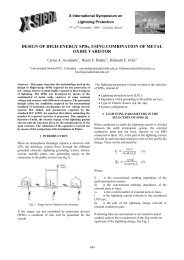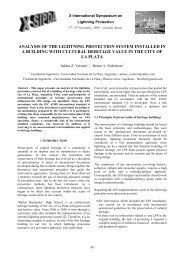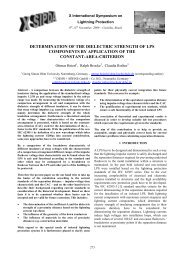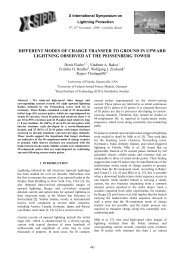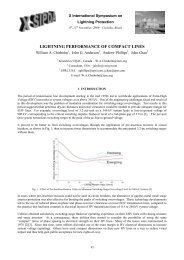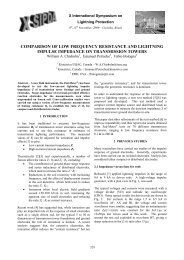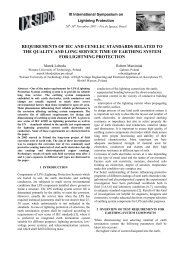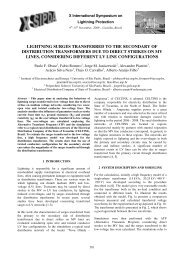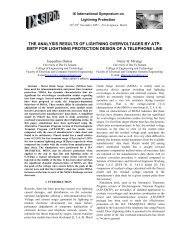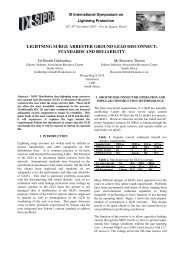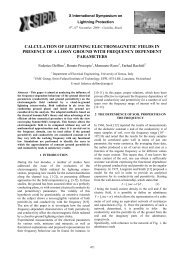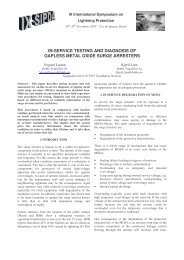calculation of the separation distance according to iec 62305-3
calculation of the separation distance according to iec 62305-3
calculation of the separation distance according to iec 62305-3
Create successful ePaper yourself
Turn your PDF publications into a flip-book with our unique Google optimized e-Paper software.
X International Symposium on<br />
Lightning Protection<br />
9 th -13 th November, 2009 – Curitiba, Brazil<br />
CALCULATION OF THE SEPARATION DISTANCE ACCORDING TO IEC<br />
<strong>62305</strong>-3: 2006-10 – REMARKS FOR THE APPLICATION AND SIMPLIFIED<br />
METHODS<br />
Alexander Kern 1 , Ottmar Beierl 2 , Wolfgang Zischank 3<br />
1 Aachen University <strong>of</strong> Applied Sciences, Germany – a.kern@fh-aachen.de<br />
2 Georg-Simon-Ohm University <strong>of</strong> Applied Sciences Nürnberg, Germany – ottmar.beierl@ohm-hochschule.de<br />
3 University <strong>of</strong> <strong>the</strong> Federal Armed Forces, Munich, Germany – wolfgang.zischank@unibw.de<br />
Abstract - The international standard IEC <strong>62305</strong>-3 [1],<br />
published in 2006, requires as an integral part <strong>of</strong> <strong>the</strong><br />
lightning protection system (LPS) <strong>the</strong> consideration <strong>of</strong> a<br />
<strong>separation</strong> <strong>distance</strong> between <strong>the</strong> conduc<strong>to</strong>rs <strong>of</strong> <strong>the</strong> LPS and<br />
metal and electrical installations inside <strong>the</strong> structure <strong>to</strong> be<br />
protected. IEC <strong>62305</strong>-3 gives two different methods for this<br />
<strong>calculation</strong>: a standard, simplified approach and a more<br />
detailed approach, which differ especially regarding <strong>the</strong><br />
treatment <strong>of</strong> <strong>the</strong> current sharing effect on <strong>the</strong> LPS<br />
conduc<strong>to</strong>rs. Hence, different results for <strong>the</strong> <strong>separation</strong><br />
<strong>distance</strong> are possible, leading <strong>to</strong> some discrepancies in <strong>the</strong><br />
use <strong>of</strong> <strong>the</strong> standard.<br />
The standard approach defined in <strong>the</strong> main part (Clause 6.3)<br />
and in Annex C <strong>of</strong> <strong>the</strong> standard in some cases may lead <strong>to</strong> a<br />
severe oversizing <strong>of</strong> <strong>the</strong> required <strong>separation</strong> <strong>distance</strong>. The<br />
detailed approach described in Annex E naturally gives<br />
more correct results. However, a <strong>calculation</strong> <strong>of</strong> <strong>the</strong> current<br />
sharing amongst all parts <strong>of</strong> <strong>the</strong> air-termination and downconduc<strong>to</strong>r<br />
network is necessary, in many cases requiring <strong>the</strong><br />
use <strong>of</strong> network analysis programs. In this paper simplified<br />
methods for <strong>the</strong> assessment <strong>of</strong> <strong>the</strong> current sharing are<br />
presented, which are easy <strong>to</strong> use as well as sufficiently<br />
adequate.<br />
1 INTRODUCTION<br />
The new standard IEC <strong>62305</strong>-3:2006-10 [1] shows some<br />
remarkable changes regarding <strong>the</strong> <strong>calculation</strong> <strong>of</strong> <strong>the</strong><br />
<strong>separation</strong> <strong>distance</strong> compared <strong>to</strong> previous versions. The<br />
method defined in <strong>the</strong> main part (Clause 6.3) and in<br />
Annex C <strong>of</strong> IEC <strong>62305</strong>-3 may lead <strong>to</strong> a severe oversizing<br />
<strong>of</strong> <strong>the</strong> required <strong>separation</strong> <strong>distance</strong>, in some cases up <strong>to</strong> a<br />
fac<strong>to</strong>r <strong>of</strong> 2.5. Fur<strong>the</strong>rmore a more detailed approach is<br />
given in Annex E <strong>of</strong> IEC <strong>62305</strong>-3. Unfortunately both<br />
methods may come <strong>to</strong> different results <strong>of</strong> <strong>the</strong> <strong>separation</strong><br />
<strong>distance</strong> for <strong>the</strong> same case. And, this is based on <strong>the</strong> same<br />
standard without any fur<strong>the</strong>r information about <strong>the</strong><br />
backgrounds <strong>of</strong> both methods. This discrepancy results in<br />
a lot <strong>of</strong> discussions among LPS planers and installers and<br />
uncertainties in education and training <strong>of</strong> specialists.<br />
This paper intends <strong>to</strong> answer some questions regarding<br />
<strong>the</strong> <strong>calculation</strong> <strong>of</strong> <strong>the</strong> <strong>separation</strong> <strong>distance</strong>. Solution<br />
methods are shown and some guidance for <strong>the</strong> practical<br />
application is given. This contains (1) a detailed<br />
description <strong>of</strong> <strong>the</strong> different methods <strong>according</strong> <strong>to</strong> IEC<br />
<strong>62305</strong>-3; (2) recommendations, under which assumptions<br />
<strong>the</strong> application <strong>of</strong> Clause 6.3 <strong>to</strong>ge<strong>the</strong>r with Annex C is<br />
useful, and for which cases <strong>the</strong> method described in<br />
Annex E is preferred; (3) an accuracy test <strong>of</strong> <strong>the</strong> method<br />
<strong>of</strong> Annex E using a electromagnetic field computing code<br />
solving correctly <strong>the</strong> Maxwell equations; (4) a simplified<br />
method <strong>to</strong> assess <strong>the</strong> current sharing coefficients for a<br />
more practical application <strong>of</strong> Annex E.<br />
2 STANDARD METHOD<br />
The standard (or simplified) method <strong>according</strong> <strong>to</strong> IEC<br />
<strong>62305</strong>-3:2006 [1] is largely identical <strong>to</strong> <strong>the</strong> method<br />
described in <strong>the</strong> preceding standards IEC 61024-1:1990<br />
and ENV 61204-1:1995 [2, 3]. The <strong>separation</strong> <strong>distance</strong><br />
between <strong>the</strong> air-terminations and <strong>the</strong> down-conduc<strong>to</strong>rs on<br />
<strong>the</strong> one hand and <strong>the</strong> metal installations and electrical<br />
systems within <strong>the</strong> structure <strong>to</strong> be protected on <strong>the</strong> o<strong>the</strong>r<br />
hand is given by:<br />
kc<br />
s ki<br />
<br />
(1)<br />
km<br />
where:<br />
k i depends on <strong>the</strong> selected class <strong>of</strong> <strong>the</strong> LPS,<br />
k c depends on <strong>the</strong> lightning current flowing in <strong>the</strong> downconduc<strong>to</strong>rs,<br />
k m depends on <strong>the</strong> electrical insulation material,<br />
is <strong>the</strong> shortest length, along <strong>the</strong> air-termination or <strong>the</strong><br />
down-conduc<strong>to</strong>r, from <strong>the</strong> point where <strong>the</strong> <strong>separation</strong><br />
<strong>distance</strong> is <strong>to</strong> be considered, <strong>to</strong> <strong>the</strong> nearest<br />
equipotential bonding point.<br />
The discrepancy <strong>of</strong> IEC <strong>62305</strong>-3 <strong>to</strong> both preceding<br />
standards [2, 3] is that <strong>according</strong> <strong>to</strong> Clause 6.3 <strong>the</strong> length<br />
267
is not only <strong>the</strong> vertical height, i.e. <strong>the</strong> length <strong>of</strong> <strong>the</strong><br />
down-conduc<strong>to</strong>rs, but <strong>the</strong> length along <strong>the</strong> airterminations<br />
or <strong>the</strong> down-conduc<strong>to</strong>rs (Fig. 1). However,<br />
<strong>the</strong> current sharing coefficient k c <strong>according</strong> <strong>to</strong> Annex C<br />
(Eq. 2) gives as a worst-case <strong>the</strong> partial current, flowing<br />
in case <strong>of</strong> a lightning strike <strong>to</strong> <strong>the</strong> edge or corner <strong>of</strong> a<br />
LPS, in <strong>the</strong> nearest, directly connected down-conduc<strong>to</strong>r.<br />
But in case <strong>of</strong> a strike <strong>to</strong> <strong>the</strong> ro<strong>of</strong> (Fig. 1) <strong>the</strong> partial<br />
currents are remarkably lower than suggested by <strong>the</strong> k c -<br />
<strong>calculation</strong> <strong>according</strong> <strong>to</strong> Annex C, due <strong>to</strong> <strong>the</strong> multiple<br />
branching <strong>of</strong> <strong>the</strong> current along <strong>the</strong> path .<br />
3 DETAILED METHOD (NODE-POTENTIAL<br />
ANALYSIS)<br />
IEC <strong>62305</strong>-3, Annex E shows a more detailed method,<br />
which was not described in <strong>the</strong> previous standards [2, 3].<br />
The required entire <strong>separation</strong> <strong>distance</strong> follows from <strong>the</strong><br />
addition <strong>of</strong> individual partial values, which arise along <strong>the</strong><br />
n lightning current carrying conduc<strong>to</strong>rs (air-terminations<br />
and down-conduc<strong>to</strong>rs). Due <strong>to</strong> current sharing different<br />
partial currents flow over <strong>the</strong> conduc<strong>to</strong>rs:<br />
ki s kc<br />
1<br />
1<br />
kc2<br />
<br />
2<br />
... kcn<br />
<br />
n<br />
(3)<br />
km<br />
An example for a large flat ro<strong>of</strong> with a mesh-type airtermination<br />
system is given in Fig. 2.<br />
k c<br />
<br />
2<br />
1<br />
11,6 %<br />
25 %<br />
Fig. 1 - Conduc<strong>to</strong>r length <strong>according</strong> <strong>to</strong> IEC <strong>62305</strong>-3 [1]<br />
3<br />
8,1 %<br />
1<br />
2n<br />
c<br />
h<br />
k 0,1 0,2 3<br />
c <br />
(2)<br />
Originally, <strong>the</strong> lightning strike <strong>to</strong> <strong>the</strong> edge or corner <strong>of</strong> a<br />
LPS was assumed <strong>to</strong> be a worst-case for <strong>the</strong> <strong>separation</strong><br />
<strong>distance</strong> covering also strikes <strong>to</strong> o<strong>the</strong>r parts <strong>of</strong> <strong>the</strong> ro<strong>of</strong>.<br />
The length naturally was only <strong>the</strong> length <strong>of</strong> <strong>the</strong> downconduc<strong>to</strong>r<br />
(i.e. <strong>the</strong> height <strong>of</strong> <strong>the</strong> structure in Fig. 1).<br />
Therefore, for <strong>the</strong> application <strong>of</strong> <strong>the</strong> standard method<br />
given in IEC <strong>62305</strong>-3, Clause 6.3 and Annex C it has <strong>to</strong><br />
be considered:<br />
- The lightning strike <strong>to</strong> edge or corner presents <strong>the</strong><br />
worst-case and covers more or less all o<strong>the</strong>r parts <strong>of</strong><br />
<strong>the</strong> ro<strong>of</strong> conservatively. Condition for this is that <strong>the</strong><br />
ro<strong>of</strong> is protected with a mesh-type air-termination<br />
system <strong>according</strong> <strong>to</strong> <strong>the</strong> selected class <strong>of</strong> LPS.<br />
- If air-termination rods or masts are used <strong>to</strong> protect<br />
ro<strong>of</strong> installations, <strong>the</strong> additionally necessary<br />
<strong>separation</strong> <strong>distance</strong> can be simply added <strong>to</strong> <strong>the</strong> value<br />
which is valid for <strong>the</strong> whole ro<strong>of</strong>.<br />
- As <strong>the</strong> length , however, in contradiction <strong>to</strong> IEC<br />
<strong>62305</strong>-3 only <strong>the</strong> length <strong>of</strong> <strong>the</strong> down-conduc<strong>to</strong>rs<br />
should be used. This was already suggested in [2, 3].<br />
In case <strong>of</strong> a ridge ro<strong>of</strong> <strong>the</strong> entire length <strong>of</strong> <strong>the</strong> downconduc<strong>to</strong>r<br />
<strong>to</strong> <strong>the</strong> ridge may be used.<br />
If especially <strong>the</strong> last point is not taken in<strong>to</strong> account, in<br />
many cases unrealistic and unnecessary high <strong>separation</strong><br />
<strong>distance</strong>s are calculated, which <strong>of</strong>ten can not be realized<br />
with “usual” means and measures.<br />
Fig. 2 - Current sharing for a large flat ro<strong>of</strong> (length <strong>of</strong> all<br />
conduc<strong>to</strong>r section is 10 m)<br />
It has <strong>to</strong> be mentioned, that <strong>the</strong> method given in Annex E<br />
simplifies <strong>the</strong> physical mechanism <strong>to</strong> a certain extent. The<br />
induced voltage in a loop as a result <strong>of</strong> <strong>the</strong> magnetic flux’<br />
time derivative is represented as <strong>the</strong> longitudinal voltage<br />
along <strong>the</strong> current carrying impedances. The errors as a<br />
result <strong>of</strong> this simplification, however, are acceptable, as<br />
shown in chapter 4.<br />
With this detailed method generally LPS <strong>of</strong> arbitrarily<br />
complex geometry can be simulated. This requires,<br />
however, <strong>the</strong> <strong>calculation</strong> <strong>of</strong> <strong>the</strong> individual values <strong>of</strong> <strong>the</strong><br />
current sharing coefficients k c . This is possible using<br />
well-established methods <strong>of</strong> <strong>the</strong> network <strong>the</strong>ory, e.g. <strong>the</strong><br />
node-potential analysis. Here, for <strong>the</strong> <strong>calculation</strong> <strong>of</strong> <strong>the</strong><br />
potentials <strong>of</strong> <strong>the</strong> individual nodes ( 1 , 2 ... n ), as <strong>the</strong><br />
result <strong>of</strong> <strong>the</strong> lightning current I 1 injected at node 1, a<br />
matrix equation has <strong>to</strong> be solved:<br />
A<br />
<br />
<br />
A<br />
...<br />
<br />
<br />
A1,<br />
1,2<br />
A<br />
2,2<br />
...<br />
2, n<br />
... An,1<br />
1<br />
1<br />
... A<br />
<br />
n,2<br />
<br />
2<br />
<br />
0<br />
<br />
... ... ... ... <br />
<br />
... An,<br />
n <br />
<br />
n 0 <br />
1,1<br />
2,1<br />
I<br />
n<br />
A<br />
A<br />
After <strong>calculation</strong> <strong>of</strong> <strong>the</strong> inverse conductance matrix<br />
<strong>the</strong> node-potentials are given as:<br />
1<br />
A <br />
1<br />
<br />
A I<br />
<br />
(4)<br />
(5)<br />
268
For this <strong>calculation</strong> also commercial network analysis<br />
programs may be used (e.g.. PSPICE, EMTP). Fig. 3<br />
shows as an example a program especially developed for<br />
lightning protection application.<br />
Fig. 3 - Calculation with a network analysis program<br />
If <strong>the</strong> detailed method <strong>according</strong> <strong>to</strong> IEC <strong>62305</strong>-3, Annex<br />
E is applied, <strong>the</strong> following has <strong>to</strong> be considered:<br />
- As <strong>the</strong> worst-case <strong>the</strong> lightning strike has <strong>to</strong> be<br />
assumed usually at <strong>the</strong> position, where <strong>the</strong> <strong>separation</strong><br />
<strong>distance</strong> should be calculated. For different positions<br />
on <strong>the</strong> ro<strong>of</strong>, normally also different values for <strong>the</strong><br />
<strong>separation</strong> <strong>distance</strong> occur.<br />
- With this method air-termination rods and masts for<br />
<strong>the</strong> protection <strong>of</strong> ro<strong>of</strong> installations can be easily taken<br />
in<strong>to</strong> account.<br />
4 REFERENCE CALCULATIONS USING THE<br />
MOM-SIMULATION PROGRAM CONCEPT II<br />
To test <strong>the</strong> accuracy <strong>of</strong> <strong>the</strong> detailed method <strong>according</strong> <strong>to</strong><br />
IEC <strong>62305</strong>-3, Annex E, comparative <strong>calculation</strong>s were<br />
performed using <strong>the</strong> computer code CONCEPT II. This<br />
code is based on <strong>the</strong> so-called Methods-<strong>of</strong>-Moments<br />
(MoM) and solves <strong>the</strong> Maxwell equations in <strong>the</strong><br />
frequency domain. The current and voltage time waveshapes<br />
<strong>the</strong>n are obtained using an inverse Fouriertransformation.<br />
The basic principle and <strong>the</strong> application <strong>of</strong><br />
CONCEPT II are described in [4, 5].<br />
The reference <strong>calculation</strong>s were performed for different<br />
structures representing typical building’s dimensions [6].<br />
We simulated structures with a base area <strong>of</strong> 20 m x 20 m<br />
and heights between 10 m and 60 m and a large flat<br />
structure with a base area <strong>of</strong> 60 m x 60 m and a height <strong>of</strong><br />
only 10 m. The structures were protected with a LPS class<br />
II:<br />
- mesh width <strong>of</strong> <strong>the</strong> air-terminations 10 m x 10 m,<br />
- <strong>distance</strong> <strong>of</strong> <strong>the</strong> down-conduc<strong>to</strong>rs 10 m,<br />
- ring conduc<strong>to</strong>rs every 10 m <strong>of</strong> height.<br />
The lightning current was injected <strong>to</strong> <strong>the</strong> corner and <strong>to</strong> <strong>the</strong><br />
center <strong>of</strong> <strong>the</strong> ro<strong>of</strong>. The lightning current was fixed with<br />
i max = 37.5 kA and T 1 = 250 ns <strong>according</strong> <strong>to</strong> Lightning<br />
Protection Level II [1]. For calculating <strong>the</strong> <strong>separation</strong><br />
<strong>distance</strong> two loops were implemented. For <strong>the</strong> corner<br />
strike a 10 m wide loop was considered, running from <strong>the</strong><br />
corner diagonally in direction <strong>to</strong> <strong>the</strong> structure’s center and<br />
from <strong>the</strong>re <strong>to</strong> <strong>the</strong> ground. For <strong>the</strong> center strike in <strong>the</strong><br />
structure’s center a vertical wire from ro<strong>of</strong> <strong>to</strong> ground was<br />
used. These loops were terminated with a high-ohmic<br />
resistance (1 M), <strong>to</strong> obtain <strong>the</strong> induced voltage in an<br />
approximately open loop. Finally from <strong>the</strong> voltages <strong>the</strong><br />
required <strong>separation</strong> <strong>distance</strong> was determined using <strong>the</strong><br />
voltage-time area criteria for air-gaps.<br />
Table 1: Comparison <strong>of</strong> <strong>the</strong> results for <strong>the</strong> <strong>separation</strong> <strong>distance</strong> s<br />
based on <strong>calculation</strong>s with <strong>the</strong> MoM simulation code<br />
CONCEPT II and <strong>according</strong> <strong>to</strong> IEC <strong>62305</strong>-3, Annex E<br />
(assumptions: k i = 0.06, k m = 1)<br />
Base area<br />
[m x m]<br />
Structure<br />
20m x 20m<br />
20m x 20m<br />
20m x 20m<br />
20m x 20m<br />
60m x 60m<br />
Height[<br />
m]<br />
10m<br />
20m<br />
40m<br />
60m<br />
10m<br />
Striking<br />
point<br />
Separation<br />
<strong>distance</strong> s [cm]<br />
MoM<br />
Annex E<br />
Error<br />
%<br />
Corner 28.7 26 -9<br />
Center 23.1 24 4<br />
Corner 43.6 36 -17<br />
Center 33.8 32 -5<br />
Corner 65.3 52 -20<br />
Center 44.4 47 6<br />
Corner 77.5 67 -14<br />
Center 52.1 62 19<br />
Corner 28.2 26 -8<br />
Center 31.5 29 -8<br />
The results are summarized in Table 1. The values<br />
obtained from <strong>the</strong> solution <strong>of</strong> <strong>the</strong> Maxwell equations via<br />
<strong>the</strong> Method-<strong>of</strong>-Moments and <strong>the</strong> values from a network<br />
analysis based on IEC <strong>62305</strong>-3, Annex E differ only by a<br />
range <strong>of</strong> + 20 %. Therefore, using <strong>the</strong> method <strong>of</strong> Annex E<br />
leads <strong>to</strong> acceptable results; <strong>the</strong> errors are clearly smaller<br />
than those <strong>of</strong> <strong>the</strong> standard method <strong>according</strong> <strong>to</strong> IEC<br />
<strong>62305</strong>-3, Clause 6.3.<br />
5 SIMPLIFIED METHODS TO ASSESS k c<br />
Methods for network analysis (Chapter 3) are <strong>of</strong>ten <strong>to</strong>o<br />
complex for practical applications in <strong>the</strong> LPS planning<br />
process. Therefore, in <strong>the</strong> following two simple methods<br />
are presented, which can be applied by <strong>the</strong> practitioner<br />
after a short “training period”. Both simple methods<br />
generally assume that between <strong>the</strong> lightning strike point<br />
and <strong>the</strong> earth-termination system multiple current sharing<br />
will occur. Due <strong>to</strong> this current sharing <strong>the</strong> partial currents<br />
will become smaller along <strong>the</strong> current path.<br />
269
In case <strong>of</strong> wide-spreaded and/or high buildings <strong>the</strong> partial<br />
current may get smaller than <strong>the</strong> physically reasonable<br />
value <strong>of</strong> 1/n (n = entire number <strong>of</strong> down-conduc<strong>to</strong>rs).<br />
This is due <strong>to</strong> <strong>the</strong> simplifications <strong>of</strong> both methods in case<br />
<strong>of</strong> a multiple application <strong>of</strong> <strong>the</strong> current sharing rules.<br />
Hence, it is necessary from this point on not <strong>to</strong> perform<br />
fur<strong>the</strong>r current sharing and <strong>to</strong> calculate with a constant<br />
k c <br />
1 / n for <strong>the</strong> remaining conduc<strong>to</strong>r sections.<br />
5.1 Current divider method<br />
In this simple method <strong>the</strong> treatment <strong>of</strong> <strong>the</strong> current sharing<br />
points follows <strong>the</strong> current divider rule. The relation <strong>of</strong> <strong>the</strong><br />
<strong>to</strong>tal current flowing in<strong>to</strong> one branching point I <strong>to</strong> <strong>the</strong><br />
partial current after <strong>the</strong> branching point I Part , which has <strong>to</strong><br />
be considered on <strong>the</strong> relevant conduc<strong>to</strong>r section, follows<br />
from <strong>the</strong> corresponding conductances:<br />
I<br />
Part<br />
GPart<br />
(6)<br />
<br />
I G<br />
<br />
<br />
V<br />
V<br />
The application <strong>of</strong> this simple current divider rule implies<br />
that all partial currents after <strong>the</strong> branching point V end in<br />
an equipotential surface (see branching destination Z in<br />
Fig. 4). In case <strong>of</strong> <strong>the</strong> <strong>separation</strong> <strong>distance</strong> <strong>calculation</strong> this<br />
is finally <strong>the</strong> earth-termination system with earth<br />
potential. For <strong>the</strong> previous branching points <strong>the</strong><br />
assumption <strong>of</strong> an equipotential surface is not valid,<br />
however. This is <strong>the</strong> simplification. Therefore, at all<br />
conduc<strong>to</strong>r sections leaving <strong>the</strong> branching point <strong>the</strong>re is<br />
<strong>the</strong> same potential difference Z - V .<br />
Fig. 4 - Current sharing at a branching point<br />
Applying <strong>the</strong> next simplification, that only conduc<strong>to</strong>rs <strong>of</strong><br />
<strong>the</strong> same material and <strong>the</strong> same cross-sectional area are<br />
used, <strong>the</strong> conductances G are simply inversely<br />
proportional <strong>to</strong> <strong>the</strong> length <strong>of</strong> <strong>the</strong> conduc<strong>to</strong>r. The partial<br />
current I Part , flowing in <strong>the</strong> considered conduc<strong>to</strong>r section,<br />
is described with <strong>the</strong> partial current coefficient k V . Using<br />
<strong>the</strong> parameter length we get for each branching point:<br />
k<br />
V<br />
I<br />
<br />
I<br />
Part<br />
<br />
1 1<br />
<br />
(7)<br />
1<br />
Part<br />
<br />
<br />
V<br />
V<br />
The individual coefficients for k c along <strong>the</strong> <strong>calculation</strong><br />
path are <strong>the</strong> result <strong>of</strong> a weighting with <strong>the</strong> partial current<br />
coefficient k V . For example, if <strong>the</strong> conduc<strong>to</strong>r section 1<br />
ends in <strong>the</strong> branching point V1, for <strong>the</strong> consecutive<br />
conduc<strong>to</strong>r section 2 it follows:<br />
k<br />
k k<br />
(8)<br />
c2 c1<br />
V1<br />
In case <strong>the</strong> path begins with a branching point V0 it is k C1<br />
= k V0 .<br />
V0<br />
V1 l 1 , k c1<br />
5 m l 2 , k c2<br />
40 m<br />
40 m<br />
Fig: 5 - Example for <strong>the</strong> application <strong>of</strong> <strong>the</strong> current divider<br />
method<br />
The procedure should be demonstrated with a <strong>calculation</strong><br />
example (Fig. 5). The path begins with <strong>the</strong> branching<br />
point V0. Here 4 partial lightning currents exist on 4<br />
conduc<strong>to</strong>r sections having <strong>the</strong> same length <strong>of</strong> 20 m. The<br />
length <strong>of</strong> <strong>the</strong> first path is 1 = 20 m. At <strong>the</strong> branching<br />
point V0 <strong>the</strong> coefficient k V0 is calculated:<br />
1 1<br />
k V<br />
<br />
1<br />
1<br />
<br />
V 0 V<br />
0<br />
k C1 = k V0 = 0.25<br />
1 1 1<br />
<br />
20 1<br />
4 <br />
4<br />
20<br />
0<br />
<br />
0.25<br />
The path continues <strong>to</strong> a branching point V1. Here 3<br />
partial currents flow on 2 conduc<strong>to</strong>r sections with 20 m<br />
length and one fur<strong>the</strong>r considered conduc<strong>to</strong>r section with<br />
5 m length <strong>to</strong> <strong>the</strong> earth-termination system. The<br />
<strong>calculation</strong> at <strong>the</strong> branching point V1 is:<br />
1<br />
<br />
<br />
1<br />
1<br />
<br />
1 1 1 1 2<br />
<br />
5 1 1 5 6<br />
2 <br />
3<br />
20 5 20<br />
k V 1<br />
<br />
<br />
3<br />
2<br />
<br />
1 V1<br />
k C2 = k C1 k V1 = 0.25 0.66 = 0.165<br />
0.66<br />
Finally, for a LPS class II (k i = 0.06) and air as <strong>the</strong><br />
isolating material (k m = 1) <strong>the</strong> <strong>separation</strong> <strong>distance</strong> s is<br />
given by:<br />
ki<br />
s <br />
k<br />
m<br />
<br />
k<br />
c1<br />
<br />
1<br />
k<br />
c2<br />
<br />
2<br />
0.06<br />
(0.25<br />
20 m 0.165 5 m) 0.35 m<br />
1<br />
<br />
<br />
270
5.2 Two-stage <strong>calculation</strong><br />
If <strong>the</strong> result shall be more accurate, especially in case <strong>of</strong><br />
unsymmetrical current sharing, <strong>the</strong> method described<br />
above can be expanded <strong>to</strong> 2 stages. If applicable, 2<br />
cascaded branching stages until <strong>the</strong> branching destination<br />
Z (equipotential surface) are considered:<br />
Fig. 6 - Current sharing for 2 cascaded branches<br />
Fig. 6 as an example presents at <strong>the</strong> end <strong>of</strong> <strong>the</strong> first<br />
conduc<strong>to</strong>r section a sub-branching point V11. Because<br />
<strong>the</strong> branching destination Z is reached only after a longer<br />
current path, if <strong>the</strong> sub-branching point is considered, also<br />
<strong>the</strong> conductance <strong>of</strong> <strong>the</strong> relevant current path decreases.<br />
This is taken in<strong>to</strong> account by using an (extended)<br />
fictitious length ’ for this current path. With that, <strong>the</strong><br />
current divider rule gives for <strong>the</strong> relevant current path<br />
“1”:<br />
1<br />
1 1<br />
<br />
(9)<br />
1<br />
<br />
<br />
V11 V11<br />
- At all fur<strong>the</strong>r branching points <strong>the</strong> current is divided<br />
by 2, independent on <strong>the</strong> number <strong>of</strong> <strong>the</strong> outgoing<br />
(continuing) conduc<strong>to</strong>rs.<br />
- If, due <strong>to</strong> multiple sharing, <strong>the</strong> partial current would<br />
be reduced below <strong>the</strong> value 1/n (n = <strong>to</strong>tal number <strong>of</strong><br />
down-conduc<strong>to</strong>rs), <strong>the</strong>re is no fur<strong>the</strong>r current sharing.<br />
For <strong>the</strong> remaining conduc<strong>to</strong>r sections <strong>the</strong> <strong>calculation</strong><br />
is performed using <strong>the</strong> value k c<br />
1/<br />
n<br />
<br />
.<br />
An application example for this method is presented in<br />
Fig. 7. At <strong>the</strong> lightning strike point „1“ <strong>the</strong> lightning<br />
current is shared <strong>to</strong> 4 conduc<strong>to</strong>rs, so that:<br />
k c1 = 1/4 = 0.25<br />
At <strong>the</strong> next node (branching point “2)“ <strong>the</strong> current is<br />
divided by 2:<br />
k c2 = 1/2 0.25 = 0.125<br />
At <strong>the</strong> following node (branching point „3“) a fur<strong>the</strong>r<br />
reduction by a fac<strong>to</strong>r <strong>of</strong> 2 would occur:<br />
k c3 = 1/2 0.125 = 0.0625<br />
This value, however, is less than <strong>the</strong> value 1/n = 1/8.<br />
Therefore, <strong>the</strong>re is no more reduction, and it is:<br />
k c3 = 1/n = 1/8 = 0.125<br />
Again assuming <strong>the</strong> values k i = 0.06 (LPS class II) and<br />
k m = 1 (air), <strong>the</strong> <strong>separation</strong> <strong>distance</strong> s follows:<br />
ki<br />
s kc<br />
1<br />
1<br />
kc2<br />
<br />
2<br />
kc3<br />
<br />
3<br />
<br />
km<br />
0.06<br />
(0.25 10 m 0.125 10 m 0.125 10 m) 0.30 m<br />
1<br />
2<br />
1<br />
1 , k c1<br />
To achieve <strong>the</strong> optimum accuracy for <strong>the</strong> <strong>calculation</strong>, <strong>the</strong><br />
method with <strong>the</strong> fictitious length must be used for all<br />
branches, where it is applicable. This is valid for all <strong>the</strong><br />
cases, where <strong>the</strong> conduc<strong>to</strong>r section considered does not<br />
terminate at <strong>the</strong> end <strong>of</strong> <strong>the</strong> <strong>calculation</strong> path (earthtermination<br />
system, equipotential bonding point).<br />
20 m<br />
3<br />
2 , k c2<br />
3 , k c3<br />
20 m<br />
5.3 Empirical method<br />
This method does not have a sound scientific basis. It was<br />
developed only by means <strong>of</strong> a larger number <strong>of</strong> examples.<br />
Again, it is assumed, that all conduc<strong>to</strong>rs <strong>of</strong> <strong>the</strong> airtermination<br />
and <strong>the</strong> down-conduc<strong>to</strong>r system have<br />
identical cross-sections and are made <strong>of</strong> <strong>the</strong> same<br />
material. The method is based on <strong>the</strong> following rules:<br />
- At <strong>the</strong> lightning strike point (or at <strong>the</strong> point, where<br />
<strong>the</strong> full lightning current is injected) <strong>the</strong> current is<br />
shared equally <strong>to</strong> all outgoing conduc<strong>to</strong>rs.<br />
20 m<br />
Fig. 7 - Example for <strong>the</strong> application <strong>of</strong> <strong>the</strong> empirical method<br />
6 COMPARISON OF THE METHODS<br />
To check and evaluate <strong>the</strong> simplified methods presented<br />
in chapter 5, <strong>the</strong> values for <strong>the</strong> <strong>separation</strong> <strong>distance</strong> s<br />
obtained with <strong>the</strong> different methods are compared with a<br />
<strong>calculation</strong>, which is based on an exact determination <strong>of</strong><br />
<strong>the</strong> individual coefficients k c along <strong>the</strong> current path with<br />
<strong>the</strong> node-potential analysis. The examination is performed<br />
271
for <strong>the</strong> same structure configurations as defined in chapter<br />
4 with a LPS class II (k i = 0.06 and k m = 1). The results<br />
for <strong>the</strong> corner strike are shown in Table 2 and for <strong>the</strong><br />
center strike in Table 3.<br />
Table 2: Comparison <strong>of</strong> <strong>the</strong> <strong>separation</strong> <strong>distance</strong> s for <strong>the</strong> detailed<br />
and for <strong>the</strong> simplified methods in case <strong>of</strong> a corner strike<br />
(Assumptions: k i = 0.06, k m = 1)<br />
Structure<br />
Separation <strong>distance</strong> s [cm]<br />
Area<br />
[m x m]<br />
Height<br />
[m]<br />
Nodepotent.<br />
analysis<br />
Current<br />
divider<br />
1-stage<br />
Current<br />
divider<br />
2-stage<br />
20m x 20m 10m 26 20 24 20<br />
20m x 20m 20m 36 28 28 30<br />
20m x 20m 40m 52 45 45 45<br />
20m x 20m 60m 67 60 60 60<br />
60m x 60m 10m 26 20 24 20<br />
Table 3: Comparison <strong>of</strong> <strong>the</strong> <strong>separation</strong> <strong>distance</strong> s for <strong>the</strong> detailed<br />
and for <strong>the</strong> simplified methods in case <strong>of</strong> a center strike<br />
(Assumptions: k i = 0.06, k m = 1)<br />
Structure<br />
Separation <strong>distance</strong> s [cm]<br />
Area<br />
[m x m]<br />
Height<br />
[m]<br />
Empirical<br />
Nodepotent.<br />
analysis<br />
Current<br />
divider<br />
1-stage<br />
Current<br />
divider<br />
2-stage<br />
Empirical<br />
20m x 20m 10m 24 20 21 23<br />
20m x 20m 20m 32 30 30 30<br />
20m x 20m 40m 47 45 45 38<br />
20m x 20m 60m 62 60 60 53<br />
60m x 60m 10m 29 25 26 28<br />
Table 4: Deviation in percent <strong>of</strong> <strong>the</strong> simplified methods<br />
compared <strong>to</strong> <strong>the</strong> detailed node-potential analysis<br />
Deviation<br />
%<br />
Current<br />
divider<br />
1-stage<br />
Corner strike<br />
Current<br />
divider<br />
2-stage<br />
Empirical<br />
Maximum -23 -22 -23<br />
Average -18 -12 -17<br />
Center strike<br />
Maximum -17 -13 -19<br />
Average -9 -7 -10<br />
Table 4 finally gives a compilation <strong>of</strong> <strong>the</strong> maximum<br />
values and <strong>the</strong> mean values <strong>of</strong> <strong>the</strong> percentage deviations<br />
between <strong>the</strong> simplified methods and <strong>the</strong> exact <strong>calculation</strong><br />
with <strong>the</strong> node-potential analysis for all structure<br />
configurations. In case <strong>of</strong> a corner strike <strong>the</strong> maximum<br />
deviations are less than 25 % and <strong>the</strong> mean values less<br />
than 20 %. For <strong>the</strong> center strike <strong>the</strong> maximum deviations<br />
are less than 20 % and <strong>the</strong> mean values less than 10 %.<br />
The 1-stage current divider method and <strong>the</strong> empirical<br />
method can be classified as approximately equal. The<br />
more elaborate 2-stage current divider method leads <strong>to</strong><br />
only marginally better results.<br />
7 CONCLUSION<br />
The standard method <strong>according</strong> <strong>to</strong> IEC <strong>62305</strong>-3, Clause<br />
6.3 generally gives a <strong>separation</strong> <strong>distance</strong> valid for <strong>the</strong><br />
entire ro<strong>of</strong>. For that, <strong>the</strong> lightning strike <strong>to</strong> <strong>the</strong> corner or<br />
<strong>the</strong> edge <strong>of</strong> <strong>the</strong> LPS has <strong>to</strong> be considered as a worst-case.<br />
However, in contradiction <strong>to</strong> IEC <strong>62305</strong>-3, as <strong>the</strong> value <br />
only <strong>the</strong> vertical length <strong>of</strong> <strong>the</strong> down-conduc<strong>to</strong>rs should be<br />
used. O<strong>the</strong>rwise unrealistic and unnecessary high<br />
<strong>separation</strong> <strong>distance</strong>s are <strong>the</strong> result.<br />
More realistic values for <strong>the</strong> <strong>separation</strong> <strong>distance</strong>s are<br />
obtained using <strong>the</strong> detailed method <strong>according</strong> <strong>to</strong> Annex E<br />
<strong>of</strong> IEC <strong>62305</strong>-3. A comparison with a <strong>calculation</strong> using<br />
<strong>the</strong> computer code CONCEPT II solving <strong>the</strong> Maxwell<br />
equations shows, that <strong>the</strong> deviations are usually less than<br />
20%. However, <strong>the</strong> method <strong>of</strong> Annex E requires <strong>the</strong><br />
knowledge <strong>of</strong> <strong>the</strong> lightning current distribution in <strong>the</strong><br />
external LPS. This usually calls for <strong>the</strong> use <strong>of</strong> network<br />
analysis programs.<br />
A possible compromise are <strong>the</strong> simplified methods for <strong>the</strong><br />
estimation <strong>of</strong> <strong>the</strong> current sharing coefficients k c . The<br />
methods presented in this paper lead <strong>to</strong> sufficiently<br />
correct results differing by less than 25 % from <strong>the</strong> exact<br />
<strong>calculation</strong>s. Especially <strong>the</strong> so-called empirical method<br />
may serve as an easy-<strong>to</strong>-apply and adequately correct<br />
procedure for <strong>the</strong> LPS planning and installation practice.<br />
8 REFERENCES<br />
[1] IEC <strong>62305</strong>-3:2006-01: Lightning protection – Part 3:<br />
Physical damage <strong>to</strong> structures and life hazard.<br />
[2] IEC 61024-1:1990-03: Protection <strong>of</strong> structures against<br />
lightning – Part 1: General principles.<br />
[3] ENV 61024-1:1995-01: Protection <strong>of</strong> structures against<br />
lightning – Part 1: General principles.<br />
[4] Brüns, H.-D.: „Pulse Generated Electromagnetic Response<br />
in Three-dimensional Wire Structures”, Ph. D. Thesis,<br />
University <strong>of</strong> <strong>the</strong> Federal Armed Forces Hamburg, Germany,<br />
1985 (in German).<br />
[5] Singer, H.; Brüns, H.-D.; Freiberg, A.: „CONCEPT II -<br />
Manual <strong>of</strong> <strong>the</strong> program system”, Universität Hamburg-<br />
Harburg, 2003.<br />
[6] Heidler, F.; Zischank, W.; Kern, A.: Analysis <strong>of</strong> necessary<br />
<strong>separation</strong> <strong>distance</strong>s for lightning protection systems<br />
including natural components. 28. International Conference<br />
on Lightning Protection (ICLP), Kanazawa (JP), 2006.<br />
272



